Friday, 24 June 2011
Distance 17 km
Duration 4 hours 10 minutes
Ascent 428 m, descent 310 m
Map 149 of the TOP100 lime-green series
Topoguide (ref. P691) Les Monts du Beaujolais et du Lyonnais… à pied
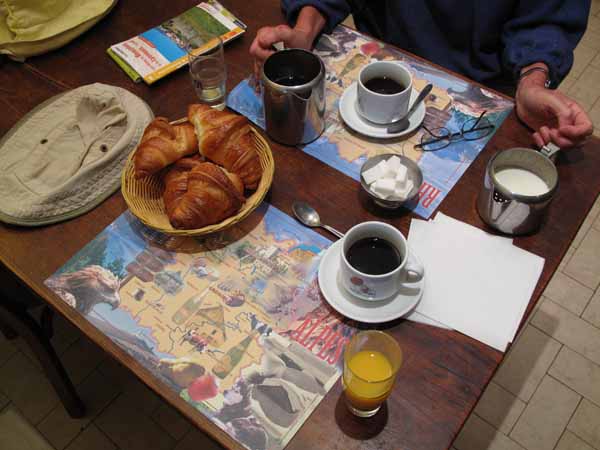
The shutters kept the room unnaturally dark and we did not stir till 6:45.
Packing up was easy without all the camping equipment to deal with, so we were downstairs at seven, but even so we were too late to catch sight of our burly fellow guests. All that remained of them was the wreckage of their breakfasts.
We settled down with our orange juice, croissants and coffee for a very pleasant and strengthening start to the day, in contrast with the last few mornings. Sunlight streamed in the windows with the promise of a fine day’s walking.
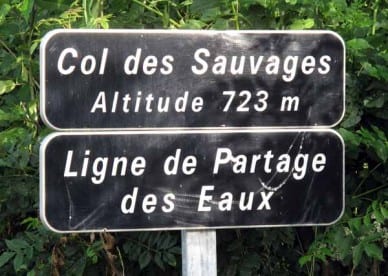
When we paid the bill, we were astonished at how little it was. The room, including breakfast, was €21, the four-course dinner, with wine, for two was €32, and the afternoon coffees, beer and aperitifs came to €7. It was undoubtedly the best value French hotel that we had ever stayed in.
We left just before eight and were soon back at les Sauvages proper, going past the other hotel, which looked desolate, we were pleased to see. We were back at last on the GR7, having left it a day and a half ago.

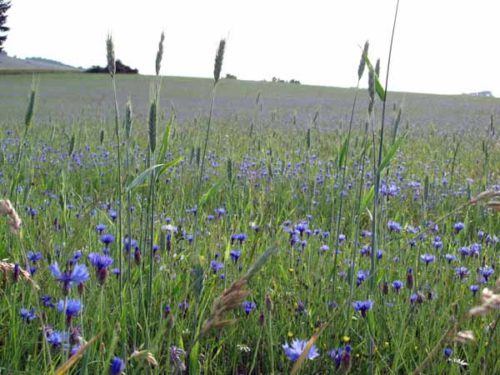
This took us up through the little town, with its church and shop and vegetable gardens, and on into the fields.
Rising further, we came to a wide, stony way, with the tell-tale straightness of a Roman road. It provided access across the mountains from the Rhône to the Loire, but fell into ruin until it was rebuilt in the seventeenth century on the orders of Louis XIV.
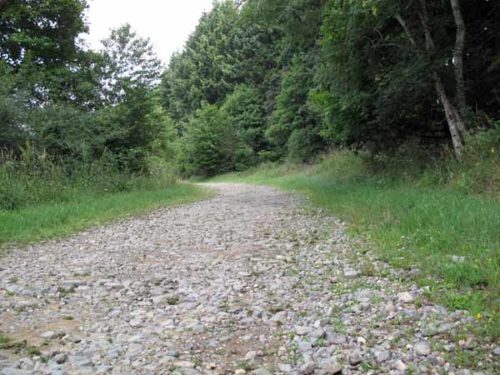
We followed this for a couple of kilometres, imagining ourselves humble seventeenth-century travellers, trudging along in the dust behind the coaches of the gentry.
As it was early in the day, we were fresh enough in the legs and well enough fed to enjoy this pretence.

At the top of the rise we came to the scattered buildings of the Col du Pin-Bouchain. This point used to be called la Chapelle, but in the anti-religious fervour following the revolution the name was changed to that of a local estate.
It was here in 1536 that James V of Scotland met François I to ask for his daughter’s hand in marriage – an unlikely spot for such a formal proposal. Why did they not meet in Paris?

The enormous highway (the N7) traversing the col jolted us back to reality and we scampered across it, dodging the trucks. There was no further sign of the old road, so we assumed it had been swallowed up by the highway.
The GR took a path up through tangled bushes, then between a field of young wheat and a pine wood. By the time we entered the wood, I was feeling hot enough to change from long trousers into shorts.

There was a wide, sandy forestry road through the trees, with occasional clearings, and we took a short cut when the GR did a typically silly thing – veering off and then sharply back for no particular reason. We just kept going and soon found the red and white marks again.
The road became churned up and muddy, and presently we found the culprit, a gigantic bulldozer which stood abandoned at the edge of the wood.
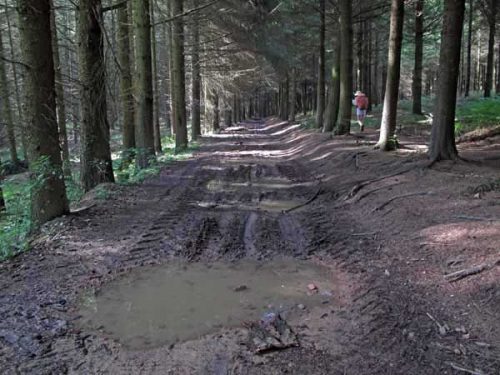
The GR signs pointed left along the road, but soon turned off along a lane that led up to a ridge covered in pines.
This ridge defined the border between the departments of Rhône and Loire, and indeed we had been on the border ever since the Col du Pin-Bouchain. The sad thing for us was that we were leaving the department where coffee was served with cream.
It was good to get out into the sunshine again. We descended to a grassy picnic ground with a lake, completely deserted on this lovely morning, then crossed a road, the D79.
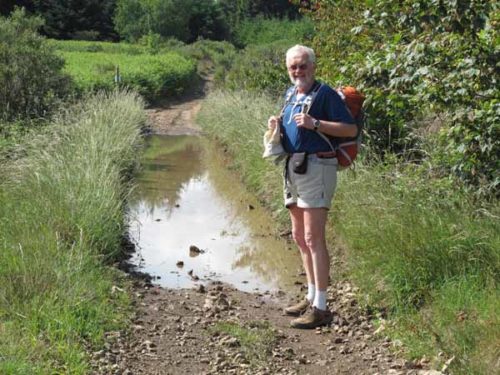
Rhône and Loire
Continuing along the border path, we came into a clearing at the high point of the ridge, with views all around of woods and pastures. The track was flooded but it was lined with bushes of wild raspberries, small and tart, which we enjoyed.
Through another stretch of pines, we reached a sunny meadow and after a while the cross of Garin, one of several way markers on the ridge.
Before leaving home, we had read about a prehistoric site at la Truche, where flint tools, as well as Roman pottery, had been found inside a drystone wall.
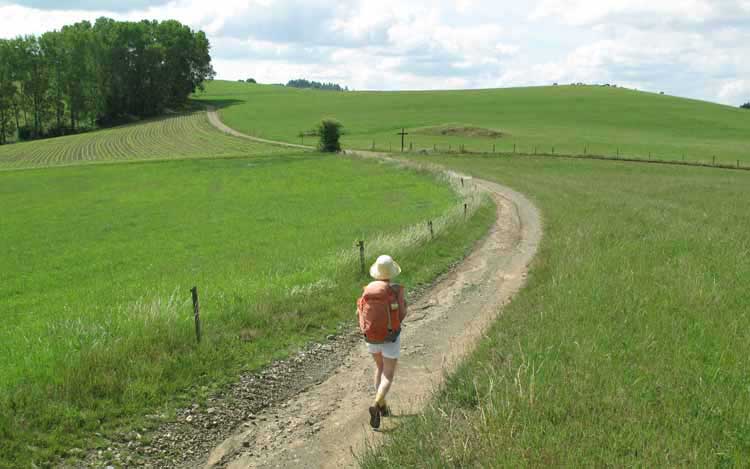
It sounded worth a visit, so at the cross of Garin we descended from the ridge to a road and then scrambled down a steep path to the hamlet of la Truche.
Nobody could accuse the locals of over-commercialising their site – we could find no sign or mention of it among the few houses that made up the place, and there was nobody around to ask. We had expected a ticket-office, brochures, even a café.
Hopeful of finding it further along the road, we wandered on, but all we found was a cherry tree, laden with fruit, which was a slight consolation.
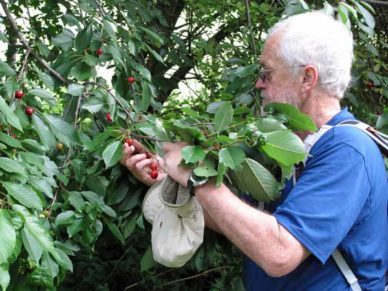
Before long we joined the main road (the D49) and entered Violay. In so doing we unwittingly circled around the ruins, which we later found out were on a hillside between la Truche and Violay.
Violay itself clung rather awkwardly to a hillside. The streets were all steep and oddly angled – we could see why there was no camping ground. Most of the buildings were only one story high on the upper side but three stories on the lower, giving them a somewhat bleak, institutional look.
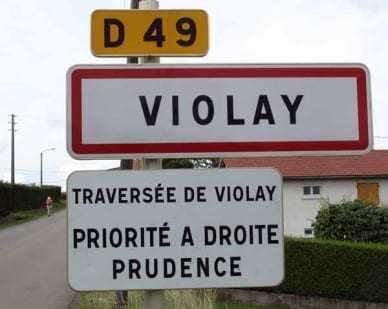
For some reason the good citizens of Violay have retained the old, dangerous road rule of priority to the right at roundabouts, which has been abandoned almost everywhere in France (except at the Arc de Triomphe in Paris).
As we came along a street of shops towards the church, we saw what we were looking for – a bar, or rather a Logis de France hotel (Hotel Perrier) with bar tables out the front. Although it was lunch time, we ordered morning coffee, and checked that they were serving dinner tonight.
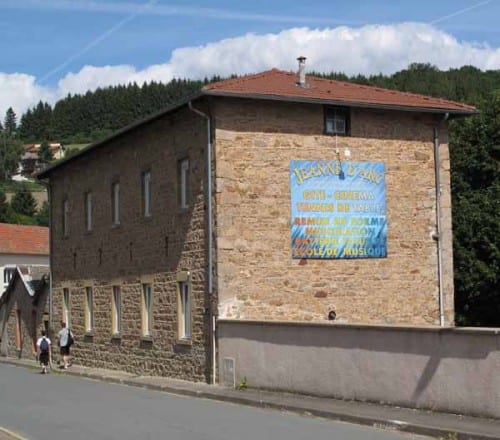
The barwoman was Asian, a rare sight in France, where Africans are much more common. She directed us to the gîte a couple of streets down, but it was locked and empty, not surprising in the middle of the day.
Keith had the idea of asking at the Mairie which was a little way along the same street, and luckily for us, the good ladies there had not closed punctually for lunch, so we were able to get in. They kindly telephoned the manager of the gîte and arranged for us to go back at 1 pm.
We sat on a park bench until the appointed hour and then reported back to the gîte, to be greeted by the woman who had prepared our room.
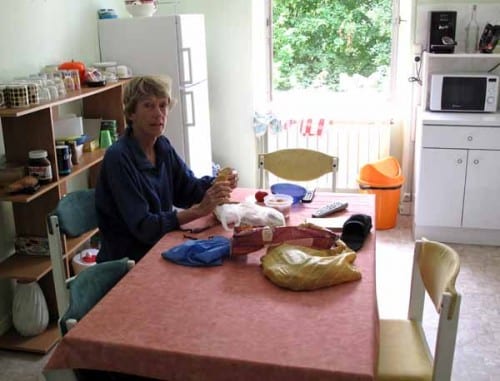
She led us up an immensely tall staircase to our room (the entry door being on the downhill side and the gîte rooms being on first floor of the uphill side), all the time rattling off advice and instructions in very fast French.
She told us that there was a worker staying here too, but no other pilgrims. Then, taking our €14 each and handing over two keys, she left us to it.
We had lunch in the kitchen, surrounded by the ouvrier’s things and feeling like trespassers, then long, lovely showers. It was a chance to wash some of our muddy outer garments.
As we lay on the cool, clean sheets for an afternoon rest, the sound of children’s singing floated in the open window from the school opposite. Singing seems to be popular in these mountain towns – we had heard various church choirs practising and there had been the wonderful reunion of the ancients at the hotel yesterday.
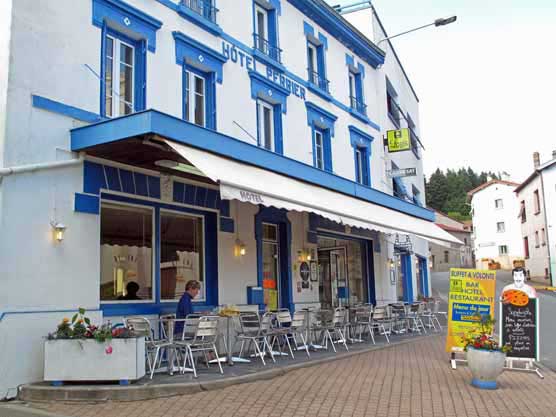
Late in the day we emerged in search of an apéritif. There was another bar in the main street but it had no terrace, so we ended up back at the Logis in the company of a horde of very bulky motor bike riders, who presently roared off.
I went back to the gîte to get the map, but could not get the key to work. By good fortune the cleaning lady was there and showed me how to raise the handle of the door, like lifting a horse’s tail, while turning the key. She looked amazed that anyone could be so stupid as to not know that.
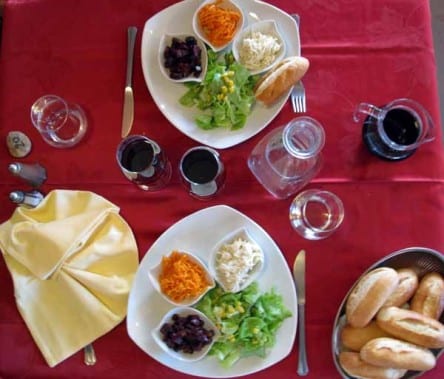
Dinner in the Hotel Perrier was not as solitary as we had expected. There were two other couples in the dining room, and a long table of well-dressed local women having the Friday special – moules et frites, so the atmosphere was quite lively.
The Vietnamese woman that we had met earlier was serving and her big French husband, his belly straining under an apron, was evidently the cook.
We had the two-course formula for €11.90, starting with a neat little plate of crudités, which was followed by the plat du jour – pork steak with potato gratin and other vegetables.
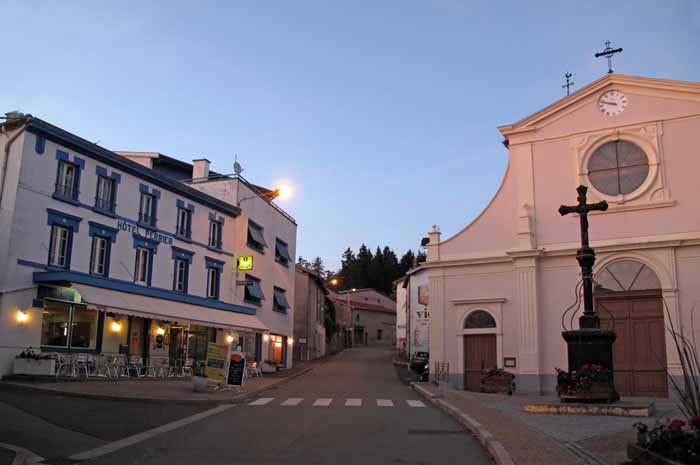
As usual we ate all the bread on the table and washed our meal down with a carafe of red wine.
While paying the bill, we asked our hostess whether she knew of a hotel in Sainte-Foy-l’Argentière, where we hoped to spend the following night, so she looked up the phone book and gave us its name and telephone number – a little bit of reassurance for tomorrow.
Nevertheless, Keith was not convinced that it was open, as he had not found any mention of it in the various accommodation websites that he had consulted before we left Australia.
Previous day: Cublize to les Sauvages